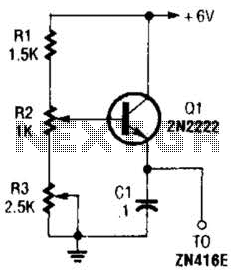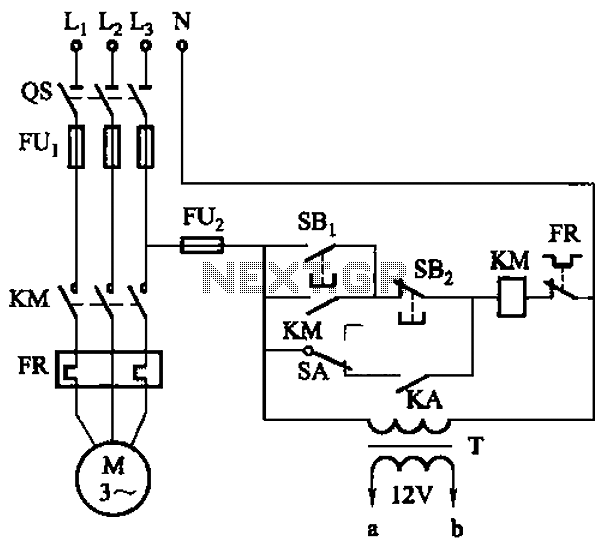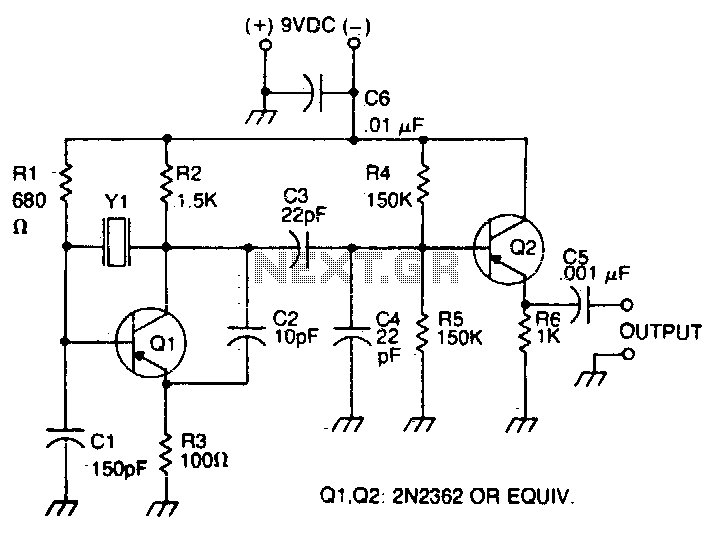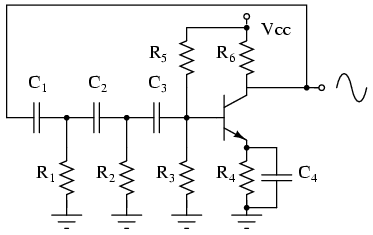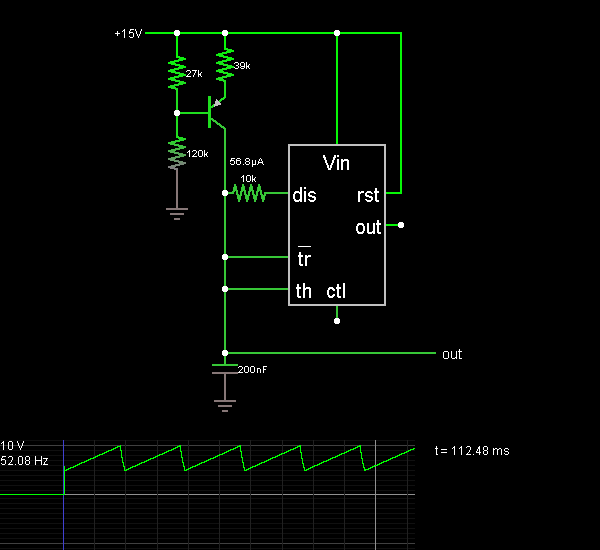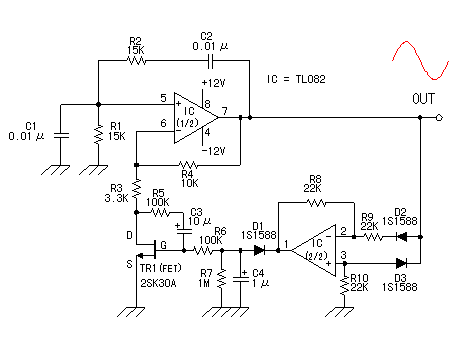
crystal oscillator circuits
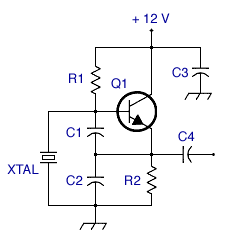
The circuit presented is a standard Colpitts oscillator, commonly utilized in many amateur radio homebrew transmitters. This specific circuit is designed to operate effectively within a frequency range of 1500 kHz to 8000 kHz. To accommodate lower frequencies, it may be necessary to increase the capacitance values of C1 and C2. For those new to circuit building, this schematic serves as an excellent starting point. The accompanying diagram illustrates the arrangement of components on a prototyping board, such as the Radio Shack catalog number 276-175. A prototyping board, also referred to as a solderless breadboard, consists of interconnected holes that securely grip the leads of components, providing an ideal platform for experimenting with circuit designs and understanding the construction process. To test the circuit, attach a 10-inch (25 cm) piece of bare wire to the output, place a radio nearby, and tune it to the crystal frequency. Upon applying power, if all connections and components are functioning correctly, the carrier signal will be audible on the receiver. To complete an AM transmitter, additional stages such as a buffer amplifier, modulation stage, final RF amplifier, harmonic suppression, and output matching section are required. An enhanced version of the circuit includes a variable capacitor between the crystal and ground, allowing slight frequency adjustments (more capacitance results in a lower frequency). Q2 acts as a buffer amplifier, stabilizing the circuit and increasing output power. This circuit variant, developed by another MWA member, employs different values for R1, C1, and C2 compared to the original circuit. Another common modification of the Colpitts circuit includes adding a resistor in parallel with the crystal, though the advantages of this change are unclear. The tested circuit operates effectively at frequencies ranging from 1.5 to 20 MHz. Additionally, a Pierce oscillator utilizing an FET is presented, with one version sourced from an electronics textbook and another from the "Grenade" shortwave pirate radio transmitter designed by "Radio Animal." Some users may prefer an oscillator that operates with a crystal at four times the desired frequency, followed by a division to produce the carrier wave. This method offers benefits such as increased frequency stability with negligible drift and the ability to order a custom crystal without revealing its broadcast-band application. However, it also introduces complexity to the circuit and results in a square wave output rich in harmonics. For those interested in this approach, a circuit inspired by the oscillator section of the Wild Planet toy transmitter is available, along with a parts layout diagram and a reconstructed schematic.
The Colpitts oscillator circuit is characterized by its use of two capacitors (C1 and C2) and an inductor (L) to create an LC tank circuit that determines the oscillation frequency. The feedback mechanism is accomplished through a combination of the capacitors and the transistor (Q1), which amplifies the signal. The frequency of oscillation can be calculated using the formula:
\[ f = \frac{1}{2\pi\sqrt{L \cdot C_{total}}} \]
where \( C_{total} = C1 \cdot C2 / (C1 + C2) + C_{stray} \). The stray capacitance, often present in the circuit, should also be considered in practical applications.
The variable capacitor in the enhanced version allows for fine-tuning of the oscillation frequency, making it adaptable for different applications. The buffer amplifier (Q2) serves to isolate the oscillator from the load, preventing any loading effects that could destabilize the oscillation.
The addition of harmonic suppression and output matching stages in the AM transmitter configuration is crucial for ensuring that the transmitted signal meets regulatory standards and minimizes interference with other communication channels. The final output stage must be designed to match the impedance of the antenna for optimal power transfer, typically 50 ohms for most radio applications.
Overall, the Colpitts oscillator is a versatile and fundamental circuit in the field of radio frequency (RF) engineering, suitable for various applications ranging from simple transmitters to more complex RF systems.The circuit below is a standard oscillator of the Colpitts variety. Similar circuits have been used in many ham radio homebrew transmitters. This particular circuit should function well at frequencies from 1500 kHz to 8000 kHz. For use on lower frequencies, the values of C1 and C2 might need to be increased. If you`ve never built a circuit from a schematic before, this might be a good one to start with. The diagram below shows how you can arrange the parts on a prototyping board such as Radio Shack catalog number 276-175. (A prototyping board, also called a solderless breadboard, contains groups of holes that are electrically connected.
Each hole has a little spring/clamp thingy in it that grabs ahold of the component leads. This is a great way to experiment with circuit designs and learn about the building process. ) Attach a 10-inch (25 cm) piece of bare wire to the output, then sit a radio next to the circuit and tune to the crystal frequency. Apply power. If everything is connected correctly and all the components are in working order, you will hear the carrier (or the silence caused by it) on your receiver.
Now all you need to do is add a buffer amp, a modulation stage, a final RF amp, a harmonic suppression and output matching section, and you`ve got an AM transmitter. :-) Below is another version of the circuit with a couple of enhancements. The variable capacitor between the crystal and ground allows you to adjust the frequency slightly. (More capacitance equals lower frequency. ) Q2 serves as a buffer amplifier which stabilizes the circuit and boosts the output power. This circuit was developed independently by another MWA member and uses very different values for R1, C1 and C2 compared to the first circuit on this page; don`t let those differences scare you.
Another common variation of the Colpitts circuit involves adding a resistor parallel to the crystal, as shown below. What`s the advantage I have no idea. The circuit shown has been tested and works fine at frequencies from 1. 5 to 20 MHz. To round out the collection, here`s a Pierce oscillator using an FET. The version on the left is from an electronics textbook. The version on the right is from the "Grenade" shortwave pirate radio transmitter designed by "Radio Animal.
" Some people might prefer an oscillator that uses a crystal at 4 times the operating frequency and then divides by four to produce the carrier wave. Advantages are 1) your signal will have a super stable frequency with immeasurably low drift, and 2) you can order a custom-made crystal without it being obvious to the manufacturer that it will be used for a broadcast-band application.
The disadvantages are 1) the circuit is more complex, and 2) the output of the oscillator will be a square-wave rich in harmonics. If you would be interested in this approach, you can consider building a circuit inspired by the design of the oscillator section of the Wild Planet toy transmitter.
You will find a parts layout diagram here and a reconstructed schematic here. 🔗 External reference
The Colpitts oscillator circuit is characterized by its use of two capacitors (C1 and C2) and an inductor (L) to create an LC tank circuit that determines the oscillation frequency. The feedback mechanism is accomplished through a combination of the capacitors and the transistor (Q1), which amplifies the signal. The frequency of oscillation can be calculated using the formula:
\[ f = \frac{1}{2\pi\sqrt{L \cdot C_{total}}} \]
where \( C_{total} = C1 \cdot C2 / (C1 + C2) + C_{stray} \). The stray capacitance, often present in the circuit, should also be considered in practical applications.
The variable capacitor in the enhanced version allows for fine-tuning of the oscillation frequency, making it adaptable for different applications. The buffer amplifier (Q2) serves to isolate the oscillator from the load, preventing any loading effects that could destabilize the oscillation.
The addition of harmonic suppression and output matching stages in the AM transmitter configuration is crucial for ensuring that the transmitted signal meets regulatory standards and minimizes interference with other communication channels. The final output stage must be designed to match the impedance of the antenna for optimal power transfer, typically 50 ohms for most radio applications.
Overall, the Colpitts oscillator is a versatile and fundamental circuit in the field of radio frequency (RF) engineering, suitable for various applications ranging from simple transmitters to more complex RF systems.The circuit below is a standard oscillator of the Colpitts variety. Similar circuits have been used in many ham radio homebrew transmitters. This particular circuit should function well at frequencies from 1500 kHz to 8000 kHz. For use on lower frequencies, the values of C1 and C2 might need to be increased. If you`ve never built a circuit from a schematic before, this might be a good one to start with. The diagram below shows how you can arrange the parts on a prototyping board such as Radio Shack catalog number 276-175. (A prototyping board, also called a solderless breadboard, contains groups of holes that are electrically connected.
Each hole has a little spring/clamp thingy in it that grabs ahold of the component leads. This is a great way to experiment with circuit designs and learn about the building process. ) Attach a 10-inch (25 cm) piece of bare wire to the output, then sit a radio next to the circuit and tune to the crystal frequency. Apply power. If everything is connected correctly and all the components are in working order, you will hear the carrier (or the silence caused by it) on your receiver.
Now all you need to do is add a buffer amp, a modulation stage, a final RF amp, a harmonic suppression and output matching section, and you`ve got an AM transmitter. :-) Below is another version of the circuit with a couple of enhancements. The variable capacitor between the crystal and ground allows you to adjust the frequency slightly. (More capacitance equals lower frequency. ) Q2 serves as a buffer amplifier which stabilizes the circuit and boosts the output power. This circuit was developed independently by another MWA member and uses very different values for R1, C1 and C2 compared to the first circuit on this page; don`t let those differences scare you.
Another common variation of the Colpitts circuit involves adding a resistor parallel to the crystal, as shown below. What`s the advantage I have no idea. The circuit shown has been tested and works fine at frequencies from 1. 5 to 20 MHz. To round out the collection, here`s a Pierce oscillator using an FET. The version on the left is from an electronics textbook. The version on the right is from the "Grenade" shortwave pirate radio transmitter designed by "Radio Animal.
" Some people might prefer an oscillator that uses a crystal at 4 times the operating frequency and then divides by four to produce the carrier wave. Advantages are 1) your signal will have a super stable frequency with immeasurably low drift, and 2) you can order a custom-made crystal without it being obvious to the manufacturer that it will be used for a broadcast-band application.
The disadvantages are 1) the circuit is more complex, and 2) the output of the oscillator will be a square-wave rich in harmonics. If you would be interested in this approach, you can consider building a circuit inspired by the design of the oscillator section of the Wild Planet toy transmitter.
You will find a parts layout diagram here and a reconstructed schematic here. 🔗 External reference
Warning: include(partials/cookie-banner.php): Failed to open stream: Permission denied in /var/www/html/nextgr/view-circuit.php on line 713
Warning: include(): Failed opening 'partials/cookie-banner.php' for inclusion (include_path='.:/usr/share/php') in /var/www/html/nextgr/view-circuit.php on line 713
